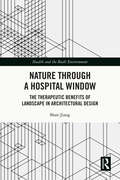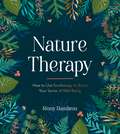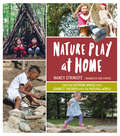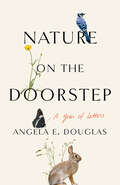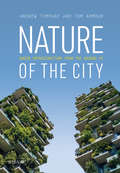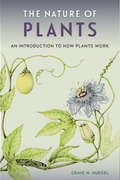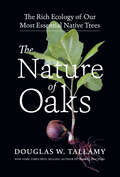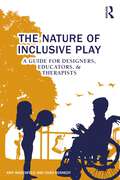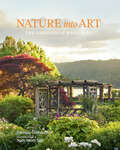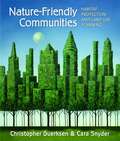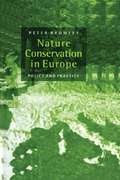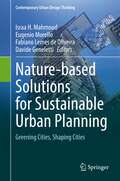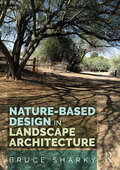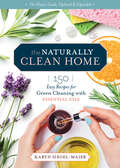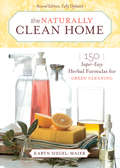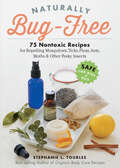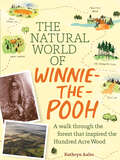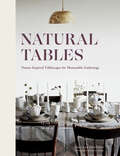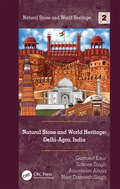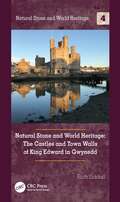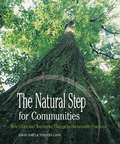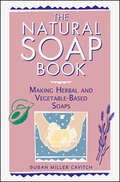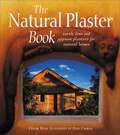- Table View
- List View
Nature through a Hospital Window: The Therapeutic Benefits of Landscape in Architectural Design (Health and the Built Environment)
by Shan JiangAdopting an evidence-based approach, this book uses two state-of-the-art experimental studies to explore nature’s therapeutic benefits in healthcare environments, emphasizing how windows and transparent spaces can strengthen people–nature interactions. High-quality, supportive, and patient-centred healthcare environments are a key priority for healthcare designers worldwide, with ageing populations creating a demand for remodeled and updated facilities. The first study demonstrates individual psychophysiological responses, moods, and preferences in simulated hospital waiting areas with different levels of visual access to nature through windows, while the second experiment uses cutting-edge immersive virtual reality techniques to explore how gardens and nature views impact people’s spatial cognition, wayfinding behaviors, and experience when navigating hospitals. Through these studies and discussions drawing on architectural theory, the book highlights the important benefits of having access to nature from hospital interiors. This concise volume will appeal to academics and designers interested in therapeutic landscapes and healthcare architecture.
Nature Therapy: How to Use Ecotherapy to Boost Your Sense of Well-Being
by Rémy DambronNature therapy is the practice of reconnecting with the natural world to refresh your physical and mental well-being. Including tips to help you discover your connection with the outdoors, activity inspiration and a holistic approach to wellness, this book is the ultimate guide to unlocking the transformative power of nature.
Nature Therapy: How to Use Ecotherapy to Boost Your Sense of Well-Being
by Rémy DambronNature therapy is the practice of reconnecting with the natural world to refresh your physical and mental well-being. Including tips to help you discover your connection with the outdoors, activity inspiration and a holistic approach to wellness, this book is the ultimate guide to unlocking the transformative power of nature.
Nature Play at Home: Creating Outdoor Spaces that Connect Children with the Natural World
by Nancy Striniste“A magnificent resource for transforming backyards into stimulating environments which enhance children’s creativity, learning, and fun.” —Richard Louv, author of Last Child in the Woods, The Nature Principle, and Vitamin N Access to technology has created a generation of children who are more plugged in than ever before—often with negative consequences. But there is a solution. Unrestricted outdoor play helps reduce stress, improve health, and enhance creativity, learning, and attention span. In Nature Play at Home, Nancy Striniste gives you the tools you need to make outdoor adventures possible in your own backyard. With hundreds of inspiring ideas and illustrated, step-by-step projects, this hardworking book details how to create playspaces that use natural materials—like logs, boulders, sand, water, and plants of all kinds. Projects include hillside slides, seating circles, sand pits, and more.
Nature on the Doorstep: A Year of Letters
by Angela E. DouglasNature on the Doorstep reveals the simple pleasures of paying attention to the natural world in one's own backyard over the course of a year. In weekly letters, Angela Douglas shares the joys and curiosities of a decidedly ordinary patch of green in upstate New York cultivated through the art of "strategic neglect"—sometimes taking a hand to manage wildlife, more often letting nature go its own way. From the first flowers of spring to cardinals singing in the winter, Douglas shows us the magic of welcoming unexpected plant and animal life into one's backyard. A paean to the richness we find when we stop to look and let be, Nature on the Doorstep celebrates the role humble backyards play both in conservation efforts and in an expanded appreciation of the living world.
Nature of the City: Green Infrastructure from the Ground Up
by Tom Armour Andrew TempanyThis is a practical guide to delivering green infrastructure from the ground up and bringing nature in to the built environment. Exploring the process of delivery through an array of design approaches and case studies, it demystifies the concept and provides the tools for practical implementation - highlighting the challenges and opportunities on both small and large projects.
The Nature of Plants: An Introduction to How Plants Work
by Craig N. HuegelPlants play a critical role in how we experience our environment. They create calming green spaces, provide oxygen for us to breathe, and nourish our senses. In The Nature of Plants, ecologist and nursery owner Craig Huegel demystifies the complex lives of plants and provides readers with an extensive tour into their workings. Beginning with the importance of light, water, and soil, Huegel describes the process of photosynthesis and how best to position plants to receive optimal sunlight. He explains why plants suffer from overwatering, what essential elements plants need to flourish, and what important soil organisms reside with them. Readers will understand the difference between friendly and hostile bacteria, fungi, and insects. Sections on plant structure and reproduction focus in detail on major plant organs—roots, stems, and leaves—and cover flowering, pollination, fruit development, and seed germination. Huegel even delves into the mysterious world of plant communication, exploring the messages conveyed to animals or other plants through chemical scents and hormones. With color illustrations, photographs, and real-life examples from his own gardening experiences, Huegel equips budding botanists, ecologists, and even the most novice gardeners with knowledge that will help them understand and foster plants of all types.
The Nature of Oaks: The Rich Ecology of Our Most Essential Native Trees
by Douglas W. Tallamy&“A timely and much needed call to plant, protect, and delight in these diverse, life-giving giants.&” —David George Haskell, author of The Forest Unseen and The Songs of Trees With Bringing Nature Home, Doug Tallamy changed the conversation about gardening in America. His second book, the New York Times bestseller Nature&’s Best Hope, urged homeowners to take conservation into their own hands. Now, he is turning his advocacy to one of the most important species of the plant kingdom—the mighty oak tree. Oaks sustain a complex and fascinating web of wildlife. The Nature of Oaks reveals what is going on in oak trees month by month, highlighting the seasonal cycles of life, death, and renewal. From woodpeckers who collect and store hundreds of acorns for sustenance to the beauty of jewel caterpillars, Tallamy illuminates and celebrates the wonders that occur right in our own backyards. He also shares practical advice about how to plant and care for an oak, along with information about the best oak species for your area. The Nature of Oaks will inspire you to treasure these trees and to act to nurture and protect them.
The Nature of Inclusive Play: A Guide for Designers, Educators, and Therapists
by Amy Wagenfeld Chad KennedyThis book provides designers, planners, educators, and therapists with the practical information required to remove inequity in outdoor spaces, by creating inviting and inclusive solutions so that all children and their families, regardless of situation or circumstance, can experience the joys and benefits of outdoor play without stigma. It is the first of its kind, co-written by an occupational therapist and landscape architect both with proven expertise in inclusive play space design. The Nature of Inclusive Play fills an untapped niche in promoting the value of outdoor play. It focuses on what embodies play and shows how, through inclusive outdoor play design, developmental skills can be enriched. The topics covered in the book include: • a discussion of the health benefits associated with being outdoors • the history of and value of play • an overview of typical child development • the importance of sensory regulation • an inclusive design review process • design guidelines. All topics are supplemented with nine applicable case studies of inclusive outdoor play spaces with features that reflect inclusive+ principles, including examples from North America and Africa. It is a much-needed guide for landscape architects, urban planners, allied health care professionals, early childhood educators, academics, and students.
Nature into Art: The Gardens of Wave Hill
by Thomas Christopher“Like Wave Hill itself, these pages make an indelible impression—wildly intimate, possibility-laden, provocative—leaving me wide awake and hungry for a visit.” —Margaret Roach, author of A Way to Garden Wave Hill, a world-renowned public garden in the Bronx, boasts a classic horticultural craftsmanship unrivaled among other public gardens in the United States. But it also embraces a design spirit that is daring and innovative. Every year brings changes to Wave Hill: new combinations of colors, textures, and forms, along with creative themes and constant experimentation. Nature into Art brings this splendid, sensory experience home by honoring the unsurpassed beauty of Wave Hill. It explores the different areas of the garden—the flower garden, the shade border, the wild garden, the conservatory, and more—and gives gardeners helpful information on the plants, techniques, and design choices that define this iconic space. Filled with stunning, ethereal photography by Ngoc Minh Ngo, Nature into Art will enchant and inspire you to practice the Wave Hill way of gardening.
Nature-Friendly Communities: Habitat Protection And Land Use Planning
by Cara Snyder Chris DuerksenNature-Friendly Communities presents an authoritative and readable overview of the successful approaches to protecting biodiversity and natural areas in America's growing communities. Addressing the crucial issues of sprawl, open space, and political realities, Chris Duerksen and Cara Snyder explain the most effective steps that communities can take to protect nature. The book: documents the broad range of benefits, including economic impacts, resulting from comprehensive biodiversity protection efforts; identifies and disseminates information on replicable best community practices; establishes benchmarks for evaluating community biodiversity protection programs. Nine comprehensive case studies of communities explain how nature protection programs have been implemented. From Austin and Baltimore to Tucson and Minneapolis, the authors explore how different cities and counties have taken bold steps to successfully protect natural areas. Examining program structure and administration, land acquisition strategies and sources of funding, habitat restoration programs, social impacts, education efforts, and overall results, these case studies lay out perfect examples that other communities can easily follow. Among the case study sites are Sanibel Island, Florida; Austin, Texas; Baltimore County, Maryland; Charlotte Harbor, Florida; and Teton County, Wyoming. Nature-Friendly Communities offers a useful overview of the increasing number of communities that have established successful nature protection programs and the significant benefits those programs provide. It is an important new work for public officials, community activists, and anyone concerned with understanding or implementing local or regional biodiversity protection efforts.
Nature Conservation in Europe: Policy and Practice
by Peter BromleyThe Rio Summit has pointed to the urgency for the development of an international conservation policy; and the post-Maastricht debates in Europe have highlighted the need for the EU to reassess structural funding in nature conservation, as well as the influences on policy and practice.This book is a 'route map' through the legislative and policy frameworks and explains how conservation works in Europe. It goes through the policies for nature conservation in the European Community and its constituent member states and sets out the mechanisms for delivering this policy.An understanding of the European legislative framework is now vital as its influence on local practice increases. Practitioners in the fields of countryside conservation and general land management will find the book an essential guide to the working of the EU, as well as helping an appreciation of their local role within the wider community objectives. This will, for example allow a better understanding of the grant system which many managers are now using.
Nature by Design: The Practice of Biophilic Design
by Stephen R. KellertBiophilia is the theory that people possess an inherent affinity for nature, which developed during the long course of human evolution. In recent years, studies have revealed that this inclination continues to be a vital component to human health and wellbeing. Given the pace and scale of construction today with its adversarial, dominative relationship with nature, the integration of nature with the built environment is one of the greatest challenges of our time. In this sweeping examination, Stephen Kellert describes the basic principles, practices, and options for successfully implementing biophilic design. He shows us what is—and isn’t—good biophilic design using examples of workplaces, healthcare facilities, schools, commercial centers, religious structures, and hospitality settings. This book will to appeal to architects, designers, engineers, scholars of human evolutionary biology, and—with more than one hundred striking images of designs—anyone interested in nature‑inspired spaces.
Nature-based Solutions for Sustainable Urban Planning: Greening Cities, Shaping Cities (Contemporary Urban Design Thinking)
by Israa H. Mahmoud Eugenio Morello Fabiano Lemes de Oliveira Davide GenelettiUrban greening policies and measures have recently shown a high potential impact on the design and reshaping of the built environment, especially in urban regeneration processes. This book provides insights on analytical methods, planning strategies and shared governance tools for successfully integrating Nature-Based Solutions (NBS) in the urban planning practice. The selected contributions present real-life application cases, in which the mainstreaming of NBS are investigated according to two main challenges: the planning and designing of physical and spatial integration of NBS in cities on one side, and the implementation of suitable shared governance models and co-creation pathways on the other. Chapter 5 is available open access under a Creative Commons Attribution 4.0 International License via link.springer.com.
Nature-Based Design in Landscape Architecture
by Bruce SharkyNature-Based Design in Landscape Architecture showcases a range of built works designed by landscape architects from many countries of the world representing diverse environmental regions and uses. These projects demonstrate the transformative potential of a nature-based approach to landscape architecture.The nature-based design approach supports and encourages natural regeneration with a view to promoting sustainable environments, preserving natural resources, and mitigating the impacts of climate change and development. The projects selected for this book demonstrate the potential of nature-based landscape design to support healthy, natural and managed ecosystems, sequester carbon, and support the recovery of biodiversity. In addition to examples of design-led environmental interventions, Nature-Based Design in Landscape Architecture, the book, also demonstrates the potential for nature-based design to improve people’s relationship with their surroundings by encouraging them to be active participants in their communities. As such, each project featured in the book promotes a discussion around future scenarios in which landscape architects can and will be engaged, from minimizing environmental impact through sustainable design to fostering social justice through community engagement.This book will be a welcome supplement for undergraduate landscape architecture, survey or design studio courses, and may also be used at the master’s degree level either as part of a landscape architecture survey seminar or early design studio.
The Naturally Clean Home, 3rd Edition: 150 Nontoxic Recipes for Cleaning and Disinfecting with Essential Oils
by Karyn Siegel-MaierIn this updated edition of her best-selling book, The Naturally Clean Home, Karyn Siegel-Maier brings together the formulas for home cleaning solutions that readers have trusted for years with new information and ingredients updated to today&’s green standards. A new introduction shines a light on the antiseptic properties of essential oils, addressing different grades of oil and their effectiveness against bacteria and viruses, as well as updated safety precautions and cost. Updated recipes eliminate Borax (banned as a food additive in the US and from cosmetic and cleaning products in the EU) from ingredient lists, replacing it with safe substitutes that include citric acid powder, hydrogen peroxide, diatomaceous earth, cornstarch, washing soda, and baking soda. New recipes show readers how to make easy, nontoxic, environmentally friendly substitutes for popular cleaning products, including molded laundry and dishwasher tablets. Packaging updates emphasize the use of glass containers for homemade cleaning products, to diminish environmental impact of plastic waste.
The Naturally Clean Home: 150 Super-Easy Herbal Formulas for Green Cleaning
by Karyn Siegel-MaierKeep your home clean, green, and healthy! Learn how to disinfect and freshen your house using powerful all-natural cleaners made by mixing essential oils together with common nontoxic kitchen ingredients like baking soda, lemon, and vinegar. Discover how fruits and herbs can brighten any room with revitalizing scents.
Naturally Bug-Free: 75 Nontoxic Recipes for Repelling Mosquitoes, Ticks, Fleas, Ants, Moths & Other Pesky Insects
by Stephanie L. TourlesProtect yourself, your children, your pets, and your home from bugs — without using harsh or toxic chemicals! Herbalist Stephanie Tourles offers 75 simple recipes for safe, effective bug repellents you can make at home from all-natural ingredients. For protection from mosquitos, ticks, and other biting insects, there are sprays, balms, body oils, and tinctures, with scents ranging from eucalyptus to floral, lemon, vanilla, and woodsy spice. There are also recipes for pets, such as herbal shampoo, bedding formulas, and flea-and-tick collars and powders. And Tourles includes repellents for the home, such as sachets that repel moths, carpet powders that repel fleas and ants, and essential oil repellents to keep your pantry pest-free. A detailed ingredient dictionary explains the properties of all the herbs, essential oils, and other key ingredients.
The Natural World of Winnie-the-Pooh: A Walk Through the Forest that Inspired the Hundred Acre Wood
by Kathryn AaltoLoved “Goodbye Christopher Robin”? Learn more about the real place that inspired the beloved stories. Delve into the home of the world’s most beloved bear! The Natural World of Winnie-the-Pooh explores the magical landscapes where Pooh, Christopher Robin, and their friends live and play. The Hundred Acre Wood—the setting for Winnie-the-Pooh’s adventures—was inspired by Ashdown Forest, a wildlife haven that spans more than 6,000 acres in southeast England. In the pages of this enchanting book you can visit the ancient black walnut tree on the edge of the forest that became Pooh’s house, go deep into the pine trees to find Poohsticks Bridge, and climb up to the top of the enchanted Galleons Lap, where Pooh says goodbye to Christopher Robin. You will discover how Milne's childhood connection with nature and his role as a father influenced his famous stories, and how his close collaboration with illustrator E. H. Shepard brought those stories to life. This charming book also serves as a guide to the plants, animals, and places of the remarkable Ashdown Forest, whether you are visiting in person or from the comfort of your favorite armchair. In a delightful narrative, enriched with Shepard’s original illustrations, hundreds of color photographs, and Milne’s own words, you will rediscover your favorite characters and the magical place they called home.
Natural Tables: Nature-Inspired Tablescapes for Memorable Gatherings
by Shellie PomeroyLearn to create dazzling tablescapes inspired by nature's beauty with this essential guide to styling stunning tablescapes for any occasion.Discover endless inspiration for stunning table settings. Brimming with inspired table spreads and simple-to-follow tips for incorporating crowd-pleasing recipes and lovely details into every presentation, this gorgeous coffee table book makes it easy to host warm, memorable gatherings—whether you're putting together a cozy brunch, a themed cocktail hour, or a festive holiday party.Photographs of exquisite table settings are paired with helpful styling tips—including how to pick your theme and color palette, select the right tableware, and incorporate nature's bounty—plus simple-to-follow food and drink recipes that guarantee the spreads taste as good as they look.Readers will discover a botanical-themed cocktail cart, an ethereal ocean-inspired setting, a harvest table celebrating autumnal colors, and so much more.EXPERT AUTHOR: Shellie Pomeroy is a celebrated designer and textile artist. Her work has been covered in Martha Stewart Wedding, Vogue, The Knot, and Style Me Pretty, among others. She shares all her secrets to creating showstopping displays using tableware, flowers, candles, fabrics, and more.GIFT WORTHY: With cloth accents and brimming with hundreds of inspired photographs, this book makes a beautiful statement on any coffee table or bookshelf, and a lovely gift for new homeowners, newlyweds, nature lovers, and design enthusiasts.Perfect for:• People who love Joanna Gaines's Magnolia brand or Magnolia Table book• Fans of Platters And Boards, Tables And Spreads, and A Year In Flowers
Natural Stone and World Heritage: Delhi-Agra, India (Natural Stone and World Heritage)
by Gurmeet Kaur Sakoon N. Singh Anuvinder Ahuja Noor Dasmesh SinghThis book discusses heritage stones which were used in the making of the architectonic heritage of Delhi and Agra, encompassing UNESCO world heritage sites and heritage sites designated as prominent by the Indian government. The most famous monument of the two cities is the ‘Taj Mahal’ of Agra. The book focuses on the geological characteristics of the famous Makrana marble, red sandstone and other sandstone variants of the Vindhyan basin and Delhi quartzite, the most widely used stones in almost all the monuments, as well as on their quarries. The work also aims to sensitise the public to protecting and preserving the architectonic heritage of these two densely populated cities in India as repositories of our past cultures and traditions. Identifying the nature and provenance of stones/rocks used in construction will lead to better restoration for future generations, in light of the deterioration of architectonic heritage through various natural weathering agencies and anthropogenic activities. The book will serve as a useful source book to economic geologists, geologists, archaeologists, architects, historians and stone industry operators specifically and to academic and non-academic communities, travellers and tourism industry operators in general. The book will benefit students, researchers, and rock enthusiasts spanning all age groups and academic levels.
Natural Stone and World Heritage: The Castles and Town Walls of King Edward in Gwynedd (Natural Stone and World Heritage)
by Ruth SiddallThis book is about the stone used to build the castles of Edward I in North West Wales. It provides a description of the available geological resources and the building materials used in the construction of Caernarfon, Conwy, Harlech and Beaumaris Castles. It takes a broad view of this subject, placing the stone used in the castles in the context of both earlier and later buildings across the region of study, from the Neolithic up until the present day. The book will serve as a useful source book for geologists, archaeologists, architects, representatives of the natural stone industry, historians and cultural heritage management professionals specifically and for academic and non-academic communities, travellers and tourism industry operators in general.
The Natural Step for Communities
by Sarah James Torbjörn LahtiSustainability may seem like one more buzzword and cities and towns like the last places to change, but The Natural Step for Communities provides inspiring examples of communities that have made dramatic changes toward sustainability and explains how others can emulate their success.Chronicled in the book are towns like Övertorneå, whose government operations recently became 100 percent fossil fuel-free, demonstrating that unsustainable municipal practices really can be overhauled. Arguing that the process of introducing change--whether converting to renewable energy or designing compact development--is critical to success, the authors outline why well-intentioned proposals often fail to win community approval and why an integrated approach--not "single-issue" initiatives--can surmount challenges of conflicting priorities, scarce resources and turf battles.The book first clarifies the concept of sustainability, offering guiding principles--the Natural Step framework--that help identify sustainable action in any area. It then introduces the 60+ eco-municipalities of Sweden that have adopted changes to sustainable practices throughout municipal policies and operations. The third section explains how they did it and outlines how other communities in North America and elsewhere can do the same. Key to success is a democratic, "bottom-up" change process and clear guiding sustainability principles, such as the Natural Step framework.The book will appeal to both general readers wishing to understand better what sustainability means and practitioners interested in introducing or expanding sustainable development in their communities.Sarah James is the principal of a community planning consulting firm. She co-authored the American Planning Association's Planning for Sustainability Policy Guide and has published articles throughout the U.S. on this subject.Torbjörn Lahti was the planner for Sweden's first eco-municipality and is directing a five-year sustainable community demonstration project. He was instrumental in forming the Swedish National Association of Eco-municipalities.
The Natural Soap Book: Making Herbal and Vegetable-Based Soaps
by Susan Miller CavitchMaking your own soap is fun, easy, and rewarding. In this introductory guide, Susan Miller Cavitch shows you how to craft your own all-natural, wonderfully smelling soaps. Illustrated directions take you through the whole process, from buying supplies to cutting the final bars. With easy-to-follow recipes that range from classics like oatmeal and honey soap to more adventurous combinations using goat milk and borage, you’ll be inspired to make uniquely personal soaps that are gentle on your skin and a pleasure for your nose.
The Natural Plaster Book: Earth, Lime and Gypsum Plasters for Natural Homes
by Dan Chiras Deanne Bednar Cedar Rose GuelberthFor builders of natural homes (straw bale, cob, adobe, rammed earth, and other natural materials), this unique step-by-step guide takes the confusion out of choosing, mixing, and applying natural plasters.From principles to practicalities, and with every stage of the process illustrated, The Natural Plasters Book details the entire process of plastering with earth, lime, and gypsum for a long-lasting and durable finish. Starting with an overview and history of the natural building movement, the book handles a wide variety of topics including earthen plaster versus cement stucco, tools and techniques of the trade, plaster recipes, and pigmenting plaster or painting walls with natural paints. First-time builders will appreciate tips on common mistakes (and how to avoid them) discussed at each stage of the plastering process. Special focus is paid to the importance of planning and designing for earthen plasters--before building begins.The only comprehensive guide available on natural plasters, this book is written for the growing number of people who have decided to build their own natural homes as well as for professionals. Heavily illustrated with practical drawings and photographs, it also includes an extensive resource guide listing books, magazines, videos, builders, and suppliers.Marketing Plans: * Ads in Natural Home and Environmental Building & Design * National print review campaign to natural building, self-sufficiency, and environmental magazines, newsletters, websites.Cedar Rose Guelberth has been working with natural home construction and plaster techniques for 25 years and is a nationally recognized natural building educator and consultant. Dan Chiras is the author of fifteen books including The Natural House: A Guide to Healthy, Energy-Efficient, Environmental Homes (ISBN: 1-890132578, Chelsea Green, 2000). Both authors live in Colorado.Also Available The Art of Natural Building: Design, Construction, Resources TP $26.95, 0-86571-433-9 * USA Straw Bale Building: How to Plan, Design, and Build with StrawTP $24.95, 0-86571-403-7 * USA
